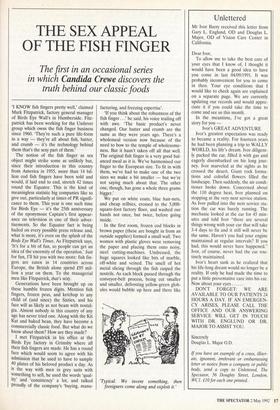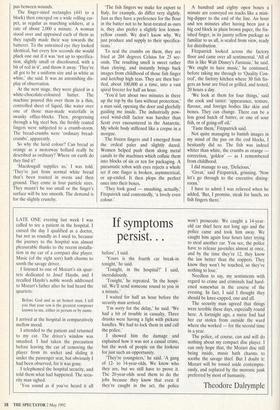THE SEX APPEAL OF THE FISH FINGER
The first in an occasional series truth behind our classic foods
'I KNOW fish fingers pretty well,' claimed Mark Fitzpatrick, factory general manager of Birds Eye Wall's in Humberside. Fitz- patrick has been working for the Unilever group which owns the fish finger business since 1960. 'They're such a pure life-form in a way — they're all about fish, batter, and crumb — it's the technology behind them that's the sexy part of them.'
The notion of the fish finger as sex object might strike some as unlikely but, since their introduction to this country from America in 1955, more than 14 bil- lion cod fish fingers have been sold and would, if laid end to end, stretch 42 times round the Equator. This is the kind of meaningless statistic big companies like to give out, particularly at times of PR signifi- cance to them. This year is one such time for Birds Eye — it's the 25th anniversary of the eponymous Captain's first appear- ance on television in one of their adver- tisements. So the Equator fact is being hailed on every possible press release and, what is more, it's even on the splash of the Birds Eye Wall's Times. As Fitzpatrick says, 'It's for a bit of fun, so people can get an idea of the enormity of the operation.' Just for fun, I'll hit you with two more: fish fin- gers are eaten in 14 countries across Europe, the British alone spend £95 mil- lion a year on them. To the managerial men like Fitzpatrick, that's sexy.
Generations have been brought up on these humble frozen digits. Mention fish fingers, frozen peas, and ketchup to any child of (and since) the Sixties, and his face will as likely as not beam with nostal- gia. Almost nobody in this country of any age has never tried one. Along with the Kit Kat and baked bean, they have become a commercially classic food. But what do we know about them? How are they made?
I met Fitzpatrick in his office at the Birds Eye factory in Grimsby where all their fish fingers are made. He has a round face which would seem to agree with his admission that he used to have to sample 40 plates of his beloved product a day. As is the way with men in grey suits with something to sell, he used the words 'qual- ity' and 'consistency' a lot, and talked proudly of the company's 'buying, manu- facturing, and freezing expertise'.
'If you think about the robustness of the fish finger ...' he said, his voice trailing off with awe. 'The basic product's never changed. Our batter and crumb are the same as they were years ago. There's a wholemeal version now because of the need to bow to the temple of wholesome- ness. But it hasn't taken off all that well. The original fish finger is a very good bal- anced meal as it is. We've harmonised our finger to the European size. To fit in with them, we've had to make one of the two sizes we make a bit smaller — but we're not saying much about that. The other one, though, has gone a whole three grams bigger.'
We put on white coats, blue hair-nets, and cheap trilbies, crossed to the 5,000- square-foot factory floor, and washed our hands not once, but twice, before going inside.
In the first room, frozen cod blocks in brown paper (these are bought in from an outside supplier) formed a small wall. Two women with plastic gloves were removing the paper and placing them onto noisy, steel cutting-machines. Undressed, the huge squares looked like bits of marble, off-white and veined. The smell of hot metal slicing through the fish rasped the nostrils. As each block passed through the conveyor-belt process, being cut smaller and smaller, defrosting yellow-green glob- ules would bubble up here and there like 'Typical. We invent something, then foreigners come along and exploit it.' pus between wounds.
The finger-sized rectangles (441 to a block) then emerged on a wide rolling car- pet, as regular as marching soldiers, at a rate of about 2,000 a minute. A woman stood over and appraised each of them as they rapidly made their way towards the batterer. To the untrained eye they looked identical, but every few seconds she would pluck one out if it was 'not up to specifica- tion, slightly small or discoloured, with a bit of red in it', and throw it away. 'They've all got to be a uniform size and as white as white,' she said. It was an astonishing dis- play of observation.
At the next stage, they were glazed in a white-chocolate-coloured batter. The machine poured this over them in a thin, controlled sheet of liquid, like water over one of those man-made waterfalls in swanky office-blocks. Then, progressing through a big steel box, the freshly coated fingers were subjected to a crumb-storm. The bread-crumbs were 'ordinary bread- crumbs', apparently.
So why the lurid colour? Can bread as orange as a motorway bollard really be described as ordinary? Where on earth do they find it?
'Macdougall supplies us,' I was told. 'They're just from normal white bread that's been toasted in ovens and then ground. They come in four particle sizes. They mustn't be too small or the finger's surface will be too smooth. The demand is for the slightly crunchy. 'The fish fingers we make for export to Italy, for example, do differ very slightly. Just as they have a preference for the flour in the batter not to be heat-treated as ours is, they also prefer a slightly less lemon- yellow crumb. We don't know why. We just produce and supply to their specifica- tions.'
To seal the crumbs on them, they are fried at 204 degrees Celsius for 25 sec- onds. The resulting smell is sweet rather than cloying, and instantly brings back images from childhood of those fish finger and ketchup high teas. They are then hur- tled, about 100,000 at a time, into a vast spiral freezer for half an hour.
'You'd last about two minutes in there up the top by the fans without protection,' a man said, opening the door and gleefully guiding me inside. The industrially pow- ered wind-chill factor was harsher than Scott ever encountered in the Antarctic. My whole body stiffened like a corpse in a morgue.
The frozen fingers and I emerged from the ordeal paler and slightly dazed. Women helped push them along metal canals to the machines which collate them into blocks of six or ten for packaging. A pneumatic robot with eyes rejects a whole set if one finger is broken, asymmetrical, or up-ended. It then plops the perfect ones into their boxes.
'They look good — smashing, actually,' Fitzpatrick said contentedly, 'a lovely even colour.' A hundred and eighty open boxes a minute are conveyed on tracks like a mini- big-dipper to the end of the line. An hour and ten minutes after having been just a big cod block in plain brown paper, the fin- ished finger, in its jaunty yellow package so familiar to us all, is sealed from view, ready for distribution.
Fitzpatrick looked across the factory floor and came over all sentimental. 'All of this is like Walt Disney's Fantasia,' he said. 'We ought to have music,' he continued, before taking me through to 'Quality Con- trol', the factory kitchen where 30 fish fin- gers an hour are fried or grilled, and tested, 20 hours a day.
'We look at them for four things,' said the cook and taster: 'appearance, texture, flavour, and foreign bodies like skin and bones. They can change. There can be a less good batch of batter, or one of soul fish, or of going-off oil.'
'Taste them,' Fitzpatrick said.
Not quite managing to banish images in my mind of the pus on the cod blocks, I hesitantly did so. The fish was indeed whiter than white, the crumbs as orange correction, 'golden' — as I remembered from childhood.
I did manage to say, 'Delicious.'
'Great,' said Fitzpatrick, grinning. 'Now let's go through to the executive dining- room.'
I have to admit I was relieved when he added, 'But, I promise, steak for lunch, no fish fingers there.'



















































 Previous page
Previous page